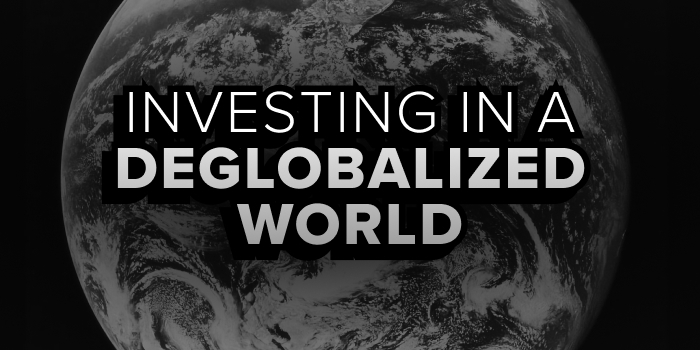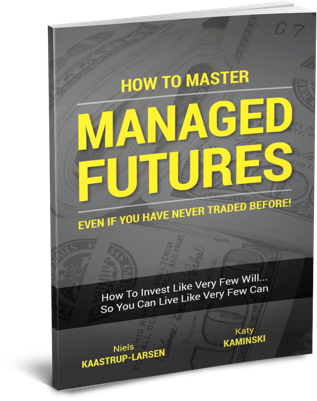Investing in a Deglobalized World

- The world is breaking into regional blocs, with trade, policy, and growth no longer moving in sync.
- As globalization gives way to fragmentation, hard assets like gold and copper are regaining importance in portfolios.
- At the same time, AI is advancing faster than economies can adapt, raising big questions about productivity, inequality, and where future returns will come from.
The illusion of a tightly connected global economy is hard to let go of. For years, investors were told the world was flattening, barriers were falling, and growth would be driven by open trade, shared technology, and synchronized monetary policy. But the evidence is piling up: that world may be gone.
The most powerful trends shaping the next few decades include deglobalization, aging populations, climate pressure, rising debt, and hyper-innovation. And they aren’t converging. They’re colliding. The result isn’t a unified future, but a fragmented one, where each region, each currency, and each policy response moves to its own rhythm.
Investors who fail to adapt risk being caught in a game that no longer plays by the rules they remember.
From Globalization to Fragmentation
Globalization was once linear, where supply chains stretched across continents and U.S. tech was the backbone of the digital world. Capital moved freely. There was one business cycle, one playbook. Now, that appears to be breaking apart.
The idea of “multi-globalization” explains what’s replacing it: not a collapse of global trade, but a redirection of it. Countries such as Vietnam, Malaysia, and India are stepping out of China’s shadow and becoming critical intermediaries in a more complicated trade web. But this workaround is fragile. Tariffs on Vietnam, for example, now run as high as 49% on some goods, a sign that rerouting trade won’t be as simple as it once seemed.
This isn't just about economics, it’s also geopolitical. Alliances are fraying and dependence is being reevaluated. Europe was once long reliant on the U.S. for energy, security, and tech, but it now faces an uncomfortable question: What happens when your biggest ally becomes unpredictable?
As one European strategist put it, “Now all of a sudden, we are in a situation where we are very, very dependent on the U.S. for energy, for our safety, and for our exports. And there’s an antagonistic president. So, we really realize we have a big, big, big problem.”
The future may hold two paths: Europe integrates, builds resilience, and reclaims agency. Or it splinters, as each nation pursues its own alignment. Neither path will be easy, but the middle ground is vanishing.
Gold, Silver, and the Quiet Shift in Global Trust
For years, gold sat somewhat quietly in the corner, dismissed as archaic. But when the U.S. froze Russian reserves and weaponized the dollar, central banks worldwide took notice. Many began shifting into gold, not for return, but for independence. This wasn’t speculation. It was, by and large, a defense.
Central banks in China, the Middle East, and parts of Asia have led the movement, buying physical gold while reducing exposure to U.S. Treasuries. Investors, on the other hand, have been slow to follow — until this year.
Now, flows are returning. Gold ETFs are seeing net inflows again. The metal is gaining traction, not because it promises yield, but because it doesn’t require trust. In a world of growing uncertainty, that matters. Maybe silver will be next. Unlike gold, it has dual demand: half industrial, half monetary. And it’s under-owned. If institutional investors return to the space, silver’s upside could mirror gold’s, with added torque.
Miners, too, have lagged. Many trade well below previous highs, even as gold prices have surged. They carry more volatility and more risk, but also more potential if the cycle continues. For diversified exposure, a common approach is 75% gold, 25% miners, generally seen as enough to capture upside, without getting whiplashed on the way.
The Energy Transition No One Agrees On
Energy policy used to be about access. Now it’s about identity.
Europe remains committed to renewables, while the U.S. is divided. China is juggling both, and markets are struggling to interpret the signals. Solar and wind equities have been hammered, with sentiment near historic lows. But raw materials, including copper, lithium, nickel, remain essential to any energy transition, regardless of who leads it.
That’s why some still see a commodity supercycle forming not because of cyclical demand, but because of structural need.
Copper stands out because supply is tight and demand keeps rising, even in a sluggish global economy. While extraction technology is improving, bringing new copper to market still takes a decade or more. Some estimates suggest the world will need 200 new mines, and few are in development. So, while prices may be flat today, the groundwork for a future surge is being laid.
Still, this is about efficiency. The transition from fossil fuels to renewables will only succeed if we can raise the energy return on investment (EROI) - how much energy we get out for every unit we put in. Wind and solar still lag oil and nuclear on this front. Until that gap narrows, the transition will remain economically fragile, no matter how politically popular it is.
Innovation Without Preparation
Artificial intelligence is everywhere. But its impact on productivity? Still TBD.
Despite the hype, macro-level productivity metrics haven’t moved much. AI has entered our lives, but not all that much inside our factories, hospitals, or infrastructure. And while white-collar tasks are being automated, it’s not yet clear whether that translates into faster economic growth. Time will tell.
What’s clear is that change is accelerating. Some estimates suggest the next generation of AI will write code better than any human. That’s not a long-term forecast. It could be months away, which raises difficult questions. Displacement is coming. But will the displaced find new jobs quickly enough? In past industrial revolutions, the adjustment took decades. If AI shortens that to a matter of years, can society keep up?
There’s also the investment angle. If wage growth stalls, consumers spend less. If companies automate too fast, inequality could spike. Owning "the robots" may be smart, but it also highlights the need for broader systemic reform across education, policy, and access.
The future will belong to those who adapt quickly. Not just technologically, but philosophically.
Why It Matters
The story investors have told themselves for decades about global alignment, cheap labor, steady growth, and central bank backstops is fracturing. What’s emerging in its place is not necessarily chaos, but a more complicated picture of moving parts.
Each region, asset class, and trend will follow its own path. Some will thrive, others will stumble. There’s no longer a single global cycle to ride, which means portfolios must be built for friction, not flow. So, what wins in this world? Likely resilience, optionality, patience. And the humility to accept that the next decade will probably look nothing like the last.
This is based on an episode of Top Traders Unplugged, a bi-weekly podcast with the most interesting and experienced investors, economists, traders and thought leaders in the world. Sign up for our Newsletter or subscribe on your preferred podcast platform so that you don't miss out on future episodes.
Most Comprehensive Guide to the Best Investment Books of All Time

Most Comprehensive Guide to the Best Investment Books of All Time
Get the most comprehensive guide to over 500 of the BEST investment books, with insights, and learn from some of the wisest and most accomplished investors in the world. A collection of MUST READ books carefully selected for you. Get it now absolutely FREE!
Get Your FREE Guide HERE!




